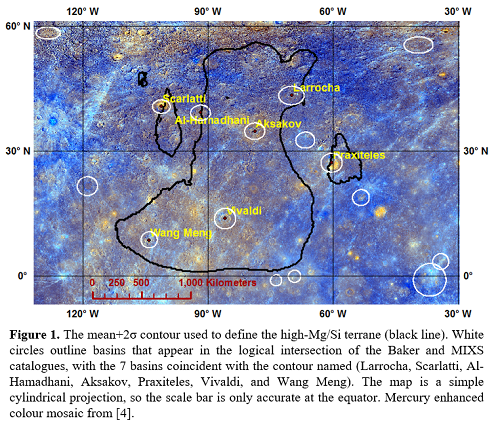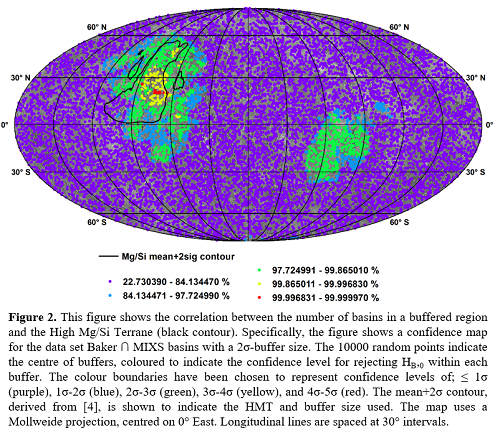The Distribution of Peak-Ring Basins on Mercury and their Correlation with the High-Mg/Si Terrane
- University of Leicester, School of Physics & Astronomy, United Kingdom of Great Britain and Northern Ireland (gph11@le.ac.uk)
Introduction: As part of the target prioritisation for the Mercury Imaging X-ray Spectrometer (MIXS), we began by cataloguing all craters that still retain a central peak (or peak-ring) structure. We report on a correlation between Mercury’s peak-ring basins and a region with high Mg/Si values determined by MESSENGER XRS [1]. We explore impact as a mechanism for the elevated Mg/Si values.
Complex craters and basins uplift material from deep crustal and upper mantle levels (e.g. [2]). Recent work on Lunar peaked craters confirm that the central peaks act as ‘drill cores’ into the lower strata revealing compositions different from the surrounding terrain [3].
The High-Mg/Si Terrane (HMT) on Mercury exhibits the highest Mg/Si ratios identified on Mercury as well as low Al/Si ratios. It covers an area from approximately 120° W to 45° W and 10° S to 50° N, with an area >5,000,000km2 [1], (Fig. 1).

Methods: Three catalogues have been used: A catalogue of all Mercurian craters that retain a central peak structure, created by the authors using [4], for target prioritization for MIXS – the ‘MIXS’ catalogue. Key features were visually categorised as MIXS-T can likely resolve them in the future; Baker et al. [6], which morphometrically catalogues peak-ring basins, protobasins, and ring-cluster basins; Fassett et al. [7], which catalogues all of the craters on Mercury with diameter ≥20km.
Excavation depth was calculated from [8] and stratigraphic uplift was calculated for key basins using methods in [9]. Stratigraphic uplift equations are assumed to only hold for material that has not been excavated and are used with caution at Mercury [9]. Crustal thickness data was taken from [10] and combined with estimated basin depths to estimate the depth to the crust-mantle boundary.
We use a one-tail test to define precise confidence contours of the HMT (originally identified by [1]) using the mean and error values from [5]. This gives the hypotheses, HC,0: Mg/Si=0.436, HC,1: Mg/Si>0.436. Using the error, σ=0.106, we determine the confidence contours for the HMT (Fig. 1).
To assess basin statistics across the planet. 10,000 random points were selected on Mercury. The points acted as the centres for circular buffers for basin-counts, with an area equal to that enclosed by the specific Mg/Si confidence contour. Another one-tailed hypothesis test was then carried out. Let µ be the mean number of basins within the buffer radius and C be the actual number of basins within the specific confidence contour, then we have the general hypotheses, HB,0: C=µ, HB,1: C>µ. The global mean and standard deviation for basin counts were calculated for each crater set, then the hypotheses were tested for each buffer to determine if a greater-than-mean basin-count is present.
Results: The greatest overall confidence level (97.7%) is for the logical intersection (∩) of the Baker and MIXS sets, within the 2σ-contour. Figure 2 shows a confidence map for this data set. A high confidence level is also observed for the Baker and MIXS sets independently (>96.7% when using a 2σ-contour), with slightly lower (~1%) confidences when protobasins and ring-cluster basins are also included. The Fassett sets exhibited confidence distributions which do not coincide with the HMT.
Uplift and excavation calculations (above) suggest that the 7 basins coincident with the contour (Figure 1) were unlikely to have brought mantle material to the surface, although all but 1 (Praxiteles) uplifted mantle material to within ~10km of the basin floor. Calculations suggest that the impacts excavated material from crustal depths of ~13km to ~20km.

Discussion: The probability of a chance correlation between high densities of basins and the HMT is low, therefore, three possible hypotheses are suggested for the observed correlation: high-Mg mantle material has been excavated and/or uplifted to the surface; high-Mg deep crustal material has been excavated and/or uplifted to the surface; impacts caused fracturing in the underlying crust, which facilitated the subsequent extrusion of high-Mg magmas.
Excavation and uplift calculations indicate mantle was unlikely to be excavated, or uplifted to the surface. Deep crustal material was almost certainly excavated, although, assuming a ubiquitous deep crustal layer of high-Mg material around Mercury, similar size craters over regions of similar thickness crust would be expected to reveal a high Mg/Si signature. Analysis of the Fassett data did not support this correlation. From the available data, it cannot be ruled out that the giant impactors have fractured the underlying crust and allowed extrusion of basaltic magmas [11]. Given the high-Mg/Si of the HMT, it is expected that these magmas might have compositions similar to magnesian basalts or basaltic komatiites [12].
Conclusion: There is a strong statistical correspondence between peak-ring basins and the HMT. There is insufficient available evidence to assign any definite causal relationship, but it is considered likely that the basin impacts have revealed primitive igneous material with high Mg/Si, which is present at crustal depths not normally revealed by other basin-sized impacts. The material may have been directly revealed or the impact may have facilitated the subsequent extrusion of high-Mg magmas. BepiColombo’s improved geographic coverage, coupled with MIXS’s higher resolution and sensitivity will hopefully answer these questions definitively.
References:[1]-Weider, S.Z. et al. (2015) Earth Planet Sc Lett, 416, 109-120. [2]-Melosh, H.J. (1989) Impact cratering: a geologic process, Oxford University Press. [3]-Moriarty, D.P. et al. (2013) J Geophy Res-Planets, 118, 2310-2322. [4]-Denevi, B. W. et al. (2017) Space Sci Rev, 214:2. [5]-Nittler, L.R. et al. in Mercury: The View After MESSENGER, C. Solomon S.R., Nittler L. and Anderson B.J., Editors. Cambridge University Press. [6]-Baker, D.M.H., et al. (2011) Planet Space Sci, 59, 1932-1948. [7]-Fassett, C.I., et al. (2011) Geophys Res Lett, 38, L10202. [8]-Potter, R.W.K. and Head, J.W. (2016) 47th LPSC, Abstract #1117. [9]-Potter, R.W.K. et al. (2013) Geophys Res Lett, 40, 5615-5620. [10]-Smith, D. E., et al. (2012), Science, 316, 214-217. [11]-Frank, E. A., et al. (2017), J Geophy Res-Planets, 122, 614-632. [12]-Phillips, R. J. et al. (2018) in Mercury: The View After MESSENGER, C. Solomon S.R., Nittler L. and Anderson B.J., Editors. Cambridge University Press. [13]-Benkhoff, J., et al. (2010), Planet Space Sci, 58, 2-20.
How to cite: Hall, G., Martindale, A., Bridges, J., and Bunce, E.: The Distribution of Peak-Ring Basins on Mercury and their Correlation with the High-Mg/Si Terrane, Europlanet Science Congress 2020, online, 21 September–9 Oct 2020, EPSC2020-1103, https://doi.org/10.5194/epsc2020-1103, 2020

